As I sit at my computer, the TV news is on in the background. I am half listening about students protesting at Columbia University in New York City and the University of Texas in Austin. Only a few weeks before, the Golden Gate Bridge was shut down by protestors using locking devices; 26 people were arrested. I won’t mention what these students were protesting because, as public safety officials, we shouldn’t really care. We need to keep our personal beliefs to ourselves. Whether we agree with the protesters or not shouldn’t make any difference in how we handle the call.
- Rescue Tools: Extricating Demonstrators and Protestors
- Safe Response to Civil Unrest Incidents
- Scenes of Violence: Campus Unrest
You might ask why this should even involve the fire department or rescue squad. In some cases, protestors use devices that they can lock themselves into to block an area—they serve as a force multiplier. At the protest on the Golden Gate Bridge, protesters used PVC pipes threaded through car windows with protesters locked on each end. Two protestors then could take up a much bigger space than if they were just side by side, and it makes it much harder for the police to make arrests. These devices can be made of many types of materials, some as small as a PVC pipe and some much larger such as a PVC pipe encased in a 55-gallon drum filled with cement.
In bigger metropolitan areas, law enforcement is equipped to handle these incidents alone with fully equipped and highly trained teams. Some have heavy rescues that will make many fire departments jealous. In areas where police do not have access to the equipment or the training, they inevitably call on the fire department for assistance in removing protesters from these locking devices.
Do not take this task lightly. There can be a lot of liability if you do not do this work properly.
Types of Protests
Most protests are not illegal by nature—a good old-fashioned sit-in that disperses after some time, a march with signs in an approved area, and even an overnight vigil in a target location to bring attention to a cause are all protests that you often don’t even hear about. They rarely require more than a small police presence and certainly do not require fire rescue other than for an accidental injury. New York City has protests almost on a weekly basis either at the United Nations or one of the dozens of embassies. Most don’t even make the news feed.
The types of protests that fire rescue may have to assist at are what are referred to as direct action protests with protester devices as described earlier. If the call is made to involve fire rescue to remove these devices, it must be done in coordination with law enforcement and with a definite incident action plan in place. This is an area where all those incident command system classes will come into play. If you do not use a unified command, then, at a minimum, the fire officer in charge needs to be part of the police incident commander’s (IC’s) team.
Initial Steps
As firefighters at one of these scenes, first we have to adjust our mindset. This IS NOT a rescue. It is an arrest situation. The protesters have locked themselves into the devices. Most, if not all, of these devices use a mini carabiner or similar device to lock in the protesters. The protesters can release themselves at any time. In fact, self-release is the best-case scenario. There have been many incidents that ended when the protesters released themselves either because they got what they came for, which was to be on the 6 o’clock news, or they just got too hot and uncomfortable and all their friends were already leaving.
Another great outcome is when the audience leaves. Protesters had set up on a college campus, blocking a street. The campus police realized it was a little-used street anyway. They made the decision to block the street at both ends, detour traffic, and clear pedestrians. When the protesters no longer had an audience, they chose to leave and come back another day. It was a good ending for all involved.
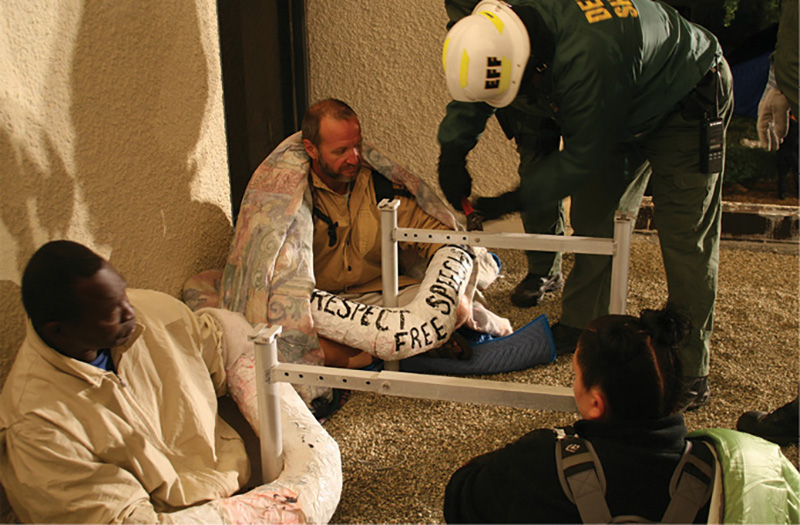
1. Protesters in sleeping dragons on a rooftop. The air-conditioning equipment needed to be dismantled just to gain access to the protesters. (Photos by author.)
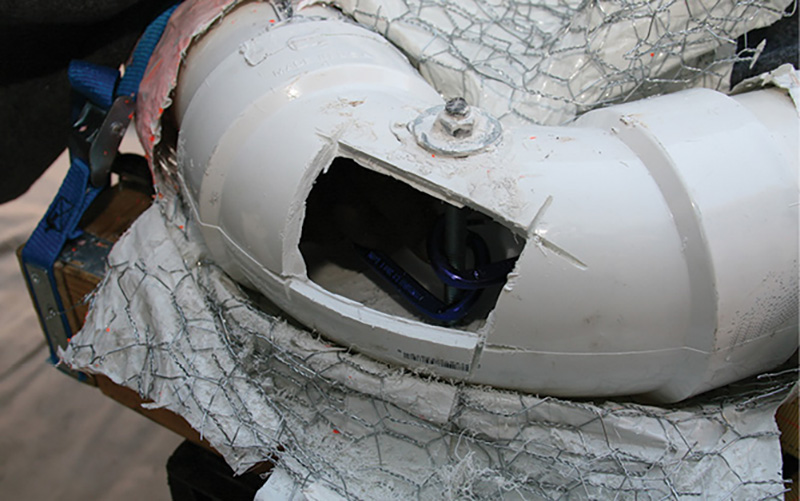
2. A completed inspection hole showing the bolt.

3. Bike locks around protesters’ necks.

4. Protesters with bike locks block the driveway to a corporate office. Other protesters have been pushed back.

5. A PVC dragon with tape and tar after removal.
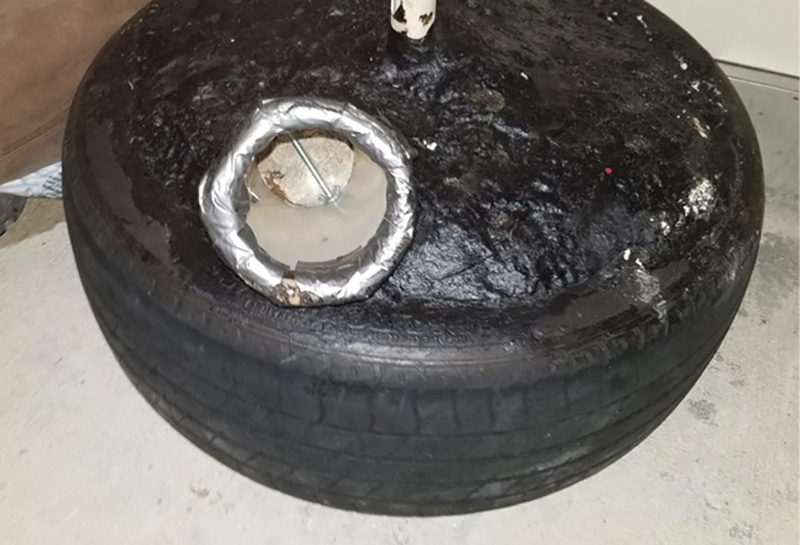
6. A PVC dragon encased in concrete in a tire.
When called in to assist in removing the device from protesters, it needs to be a team effort. As firefighters, we are used to immediate action: Pop the door, assess the patient, put him on a backboard, and into the rig he goes. When a protester is being arrested, there are a lot of moving parts, and rushing is not one of them. Scene safety and the safety of responders and other protesters are at the top of the list.
Before any action is taken, the police IC will have to have all his other elements ready to go. Using the generally accepted FEMA Field Force format, the police IC will have a field force team (possibly with helmets, shields, and riot gear) already in place to keep back crowds. Protesters in locking devices will not be touched until a safe area has been established. Preferably some sort of shielding will be put in place to block the operation from the view of other protestors. An arrest team will also be in place to take custody of the protesters as soon as they are released. The protestors will have been given several warnings and opportunities to release and surrender.
At this point, somebody always offers an expert opinion on the quickest way to effect the arrest (pepper spray or Taser®, for example). If you are working with a professional agency, they will hopefully be aware of limitations on the use of force. These protesters are displaying what is referred to as passive resistance. The high courts have made some very specific rulings about the use of force on these types of individuals, and some agencies have paid out lots of money in lawsuits to reinforce this fact.
Dragging them away is also not an option. Don’t forget, they are prisoners, and the arresting agency is responsible for their safety at that point.
Firefighters working with the police will be part of the extrication team. A law enforcement officer should be part of the team. The officer may need to testify in court that fire personnel acted appropriately. Throughout the process, the prisoners should be offered the opportunity to release themselves. When the protesters are in police custody, we also need to check on their medical condition and, if necessary, offer hydration or warmth.
Another element to this operation is documentation. The police IC will have another team tasked with recording the event. Use caution with joking around and banter. A harmless joke might seem fun at the time but not when it is played back in court. The police won’t be the only ones recording. The protesters commonly bring their own lawyers and photographers to the scene to document everything. The other part of documentation is that anything attached to a protester is evidence. It all needs to be invoiced and removed by law enforcement to aid in a successful prosecution of the case.
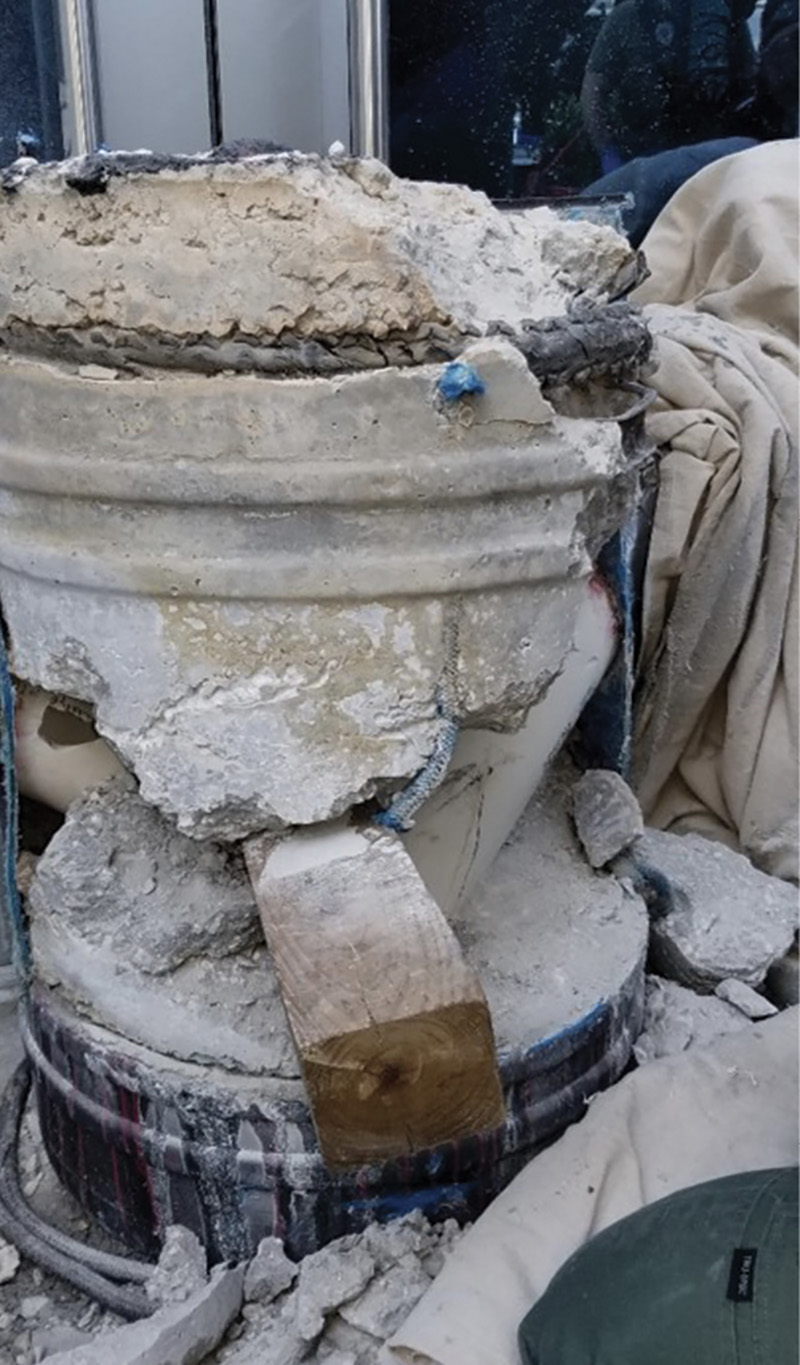
7. A PVC dragon encased in concrete in a 55-gallon drum. This was next to plate glass windows, making the extrication more difficult.
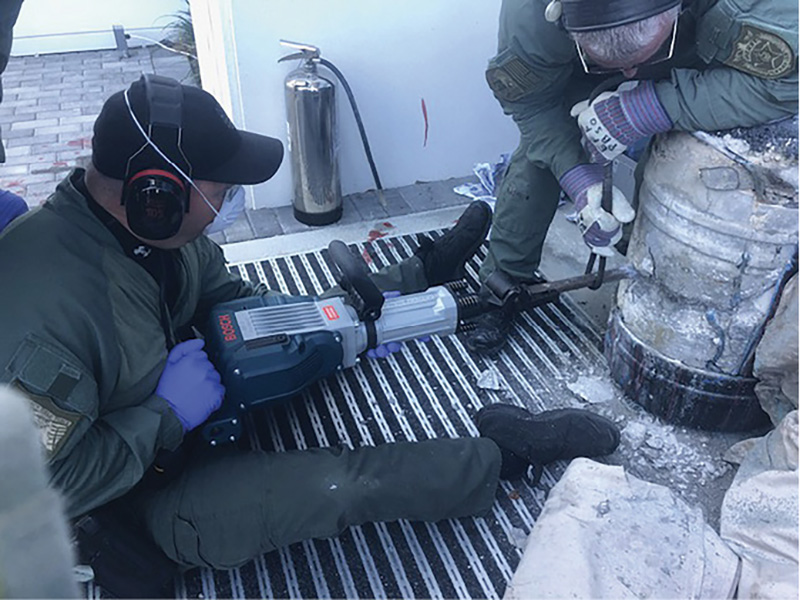
8. An extrication team works on a concrete dragon.
Removing the Devices
The most common device that protestors lock themselves into is what is commonly referred to as a sleeping dragon. It is a piece of PVC pipe with a bolt through the middle. The protestors have a chain or webbing around their wrist and attach themselves to the dragon with a small carabiner type of device. Sleeping dragons come in several varieties. They may have anything from tape and tar or maybe human waste wrapped around them to being embedded in a concrete bucket or even a 55-gallon drum. The purpose of adding anything around the PVC pipe is to slow down the extrication team and gum up the tools.
Another very common locking protester device is a U-shaped bike lock attached around the neck of a protester and then a second lock threaded through it and around another protester’s neck. The protesters’ imagination is the only thing limiting what type of device they can make, but these are some of the most common.
To defeat the sleeping dragon, the extrication team would make an inspection hole in the PVC tube. This will expose the bolt. After you gain access, use a bolt cutter to cut either the bolt across the pipe or the chain attached to the protester. Making the inspection hole requires techniques that can only be learned with training. Of course, just getting to the PVC can be a task when it is covered with concrete or tar. Bike locks can usually be cut with a rebar cutter or a rotary tool.
Training
Training is key. FEMA’s Center for Domestic Preparedness (CDP) offers a free three-day class on removing protesters from devices called “Field Force Extrication.” It is open to law enforcement and the fire service. In the rescue world, we can’t possibly train for every scenario, but we do train on our equipment. In the world of protests, it is very common to see the same type of device over and over. This is why training on the most common devices at minimum is crucial. If a case ends up in court, you will be expected to explain why you hurt someone doing a task that training is available for.
Cutting PVC until it is less than paper thin is also a skill that diminishes without use. Training is essential for would-be rescuers. During training is when you should determine each team member’s strengths and weaknesses. Each team member should also train with live subjects (other team members) on the device. This may sound like overkill, but during court testimony it can bolster the case for your teams’ professional actions.
Most rescue companies already have the necessary tools, but the tactics for using them may need to be tweaked. It is essential to work within the law enforcement incident command structure to ensure that no one gets hurt and successful arrest and prosecution of criminals can take place. If your department has not already worked with local law enforcement on a protest situation, then it is probably time to have a meeting and make some preliminary plans as to how these assignments might be handled.
James Edelstein is a 30-year career law enforcement officer with experience in New York and Florida. He has served in both SWAT and Field Force capacities. He has participated in several national special security events as well as presidential security and motorcade details. He is also a firefighter/instructor and extrication instructor at the Center for Domestic Preparedness.

